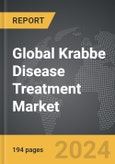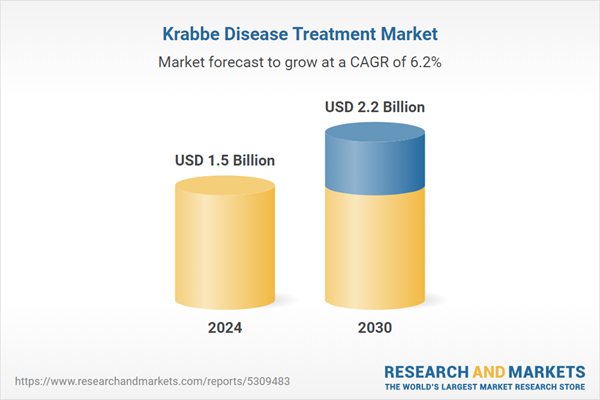The global market for Krabbe Disease Treatment was valued at US$1.5 Billion in 2024 and is projected to reach US$2.2 Billion by 2030, growing at a CAGR of 6.2% from 2024 to 2030. This comprehensive report provides an in-depth analysis of market trends, drivers, and forecasts, helping you make informed business decisions. The report includes the most recent global tariff developments and how they impact the Krabbe Disease Treatment market.
Segments: Therapy (Anticonvulsants, Muscle Relaxants, Hematopoietic Stem Cell Transplantation (HSCT), Other Therapies).
Geographic Regions/Countries: World; United States; Canada; Japan; China; Europe (France; Germany; Italy; United Kingdom; and Rest of Europe); Asia-Pacific; Rest of World.
The analysts continuously track trade developments worldwide, drawing insights from leading global economists and over 200 industry and policy institutions, including think tanks, trade organizations, and national economic advisory bodies. This intelligence is integrated into forecasting models to provide timely, data-driven analysis of emerging risks and opportunities.
Global Krabbe Disease Treatment Market - Insights & Medical Advancements
What Is Krabbe Disease and Why Is It a Significant Focus in Rare Disease Research?
Krabbe disease, also known as globoid cell leukodystrophy, is a rare and often fatal genetic disorder that affects the central nervous system. It is caused by mutations in the GALC gene, which lead to the accumulation of galactolipids in the brain, resulting in the destruction of the myelin sheath that insulates nerve cells. This progressive demyelination causes severe neurological impairment, including developmental delays, muscle weakness, and vision loss, often leading to death in early childhood. Due to its rarity and the severe nature of its symptoms, Krabbe disease is a significant focus in rare disease research. The condition poses considerable challenges for diagnosis and treatment, with current therapeutic options being limited primarily to symptomatic management and bone marrow transplantation in very early stages. However, ongoing research is exploring novel treatment approaches, including gene therapy and enzyme replacement therapy, to provide more effective and potentially curative options.How Are Advancements in Gene Therapy and Early Diagnosis Impacting Krabbe Disease Treatment?
Advancements in gene therapy and early diagnosis are significantly impacting the landscape of Krabbe disease treatment, offering new hope for affected individuals and their families. Gene therapy, which involves delivering a functional copy of the defective GALC gene to the patient’s cells, is one of the most promising areas of research. Preclinical studies and early-phase clinical trials have shown that gene therapy has the potential to halt or even reverse the progression of Krabbe disease by restoring the enzyme activity needed to prevent toxic buildup in the brain. Additionally, improvements in newborn screening programs are enabling earlier diagnosis of Krabbe disease, which is crucial for the timely initiation of treatment. Early detection allows for interventions such as hematopoietic stem cell transplantation (HSCT), which has been shown to be more effective when performed before the onset of symptoms. These advancements are paving the way for more effective treatment strategies and improving the prognosis for patients with Krabbe disease.What Challenges Does the Krabbe Disease Treatment Market Face?
The Krabbe disease treatment market faces several challenges, including the rarity of the condition, the complexity of treatment, and the high costs associated with research and therapy development. As a rare disease, Krabbe disease affects a small patient population, which can limit the financial incentives for pharmaceutical companies to invest in research and development. Additionally, the treatment of Krabbe disease, particularly in its advanced stages, is highly complex and often requires multidisciplinary care, including neurologists, geneticists, and palliative care specialists. The cost of treatments, such as gene therapy and stem cell transplantation, can be prohibitively high, raising concerns about accessibility and reimbursement. Furthermore, the development of effective therapies is challenged by the need for a deep understanding of the disease’s underlying mechanisms and the difficulties in delivering treatments across the blood-brain barrier. To address these challenges, there is a growing focus on collaboration between researchers, healthcare providers, patient advocacy groups, and pharmaceutical companies to drive innovation and ensure that emerging therapies reach those in need.What Factors Are Driving Growth in the Krabbe Disease Treatment Market?
The growth in the Krabbe disease treatment market is driven by several factors, including advancements in genetic research, increased awareness and early diagnosis, and the development of novel therapies. The rapid progress in genetic research is leading to a better understanding of the molecular mechanisms underlying Krabbe disease, paving the way for the development of targeted therapies such as gene therapy and enzyme replacement therapy. The expansion of newborn screening programs and early diagnostic tools is also driving growth by enabling earlier intervention, which is critical for improving treatment outcomes. Additionally, the increasing focus on rare diseases within the pharmaceutical industry, supported by government incentives and orphan drug designations, is spurring investment in the development of new treatments for Krabbe disease. As these advancements continue, the market for Krabbe disease treatment is expected to grow, offering new hope for patients and their families.Report Scope
The report analyzes the Krabbe Disease Treatment market, presented in terms of units. The analysis covers the key segments and geographic regions outlined below.Segments: Therapy (Anticonvulsants, Muscle Relaxants, Hematopoietic Stem Cell Transplantation (HSCT), Other Therapies).
Geographic Regions/Countries: World; United States; Canada; Japan; China; Europe (France; Germany; Italy; United Kingdom; and Rest of Europe); Asia-Pacific; Rest of World.
Key Insights:
- Market Growth: Understand the significant growth trajectory of the Anticonvulsants segment, which is expected to reach US$823.5 Million by 2030 with a CAGR of a 5.3%. The Muscle Relaxants segment is also set to grow at 5.9% CAGR over the analysis period.
- Regional Analysis: Gain insights into the U.S. market, valued at $416.7 Million in 2024, and China, forecasted to grow at an impressive 5.9% CAGR to reach $340.6 Million by 2030. Discover growth trends in other key regions, including Japan, Canada, Germany, and the Asia-Pacific.
Why You Should Buy This Report:
- Detailed Market Analysis: Access a thorough analysis of the Global Krabbe Disease Treatment Market, covering all major geographic regions and market segments.
- Competitive Insights: Get an overview of the competitive landscape, including the market presence of major players across different geographies.
- Future Trends and Drivers: Understand the key trends and drivers shaping the future of the Global Krabbe Disease Treatment Market.
- Actionable Insights: Benefit from actionable insights that can help you identify new revenue opportunities and make strategic business decisions.
Key Questions Answered:
- How is the Global Krabbe Disease Treatment Market expected to evolve by 2030?
- What are the main drivers and restraints affecting the market?
- Which market segments will grow the most over the forecast period?
- How will market shares for different regions and segments change by 2030?
- Who are the leading players in the market, and what are their prospects?
Report Features:
- Comprehensive Market Data: Independent analysis of annual sales and market forecasts in US$ Million from 2024 to 2030.
- In-Depth Regional Analysis: Detailed insights into key markets, including the U.S., China, Japan, Canada, Europe, Asia-Pacific, Latin America, Middle East, and Africa.
- Company Profiles: Coverage of players such as Abbott Laboratories, CENETOGENE N.V., GlaxoSmithKline, Johnson & Johnson, Novartis AG and more.
- Complimentary Updates: Receive free report updates for one year to keep you informed of the latest market developments.
Some of the 42 companies featured in this Krabbe Disease Treatment market report include:
- Abbott Laboratories
- CENETOGENE N.V.
- GlaxoSmithKline
- Johnson & Johnson
- Novartis AG
- Pfizer
- Sanofi-Aventis SA
- Shire
- Teva Pharmaceutical Industries Ltd.
- UCB Pharmaceuticals
Tariff Impact Analysis: Key Insights for 2025
Global tariff negotiations across 180+ countries are reshaping supply chains, costs, and competitiveness. This report reflects the latest developments as of April 2025 and incorporates forward-looking insights into the market outlook.The analysts continuously track trade developments worldwide, drawing insights from leading global economists and over 200 industry and policy institutions, including think tanks, trade organizations, and national economic advisory bodies. This intelligence is integrated into forecasting models to provide timely, data-driven analysis of emerging risks and opportunities.
What’s Included in This Edition:
- Tariff-adjusted market forecasts by region and segment
- Analysis of cost and supply chain implications by sourcing and trade exposure
- Strategic insights into geographic shifts
Buyers receive a free July 2025 update with:
- Finalized tariff impacts and new trade agreement effects
- Updated projections reflecting global sourcing and cost shifts
- Expanded country-specific coverage across the industry
Table of Contents
I. METHODOLOGYII. EXECUTIVE SUMMARY2. FOCUS ON SELECT PLAYERSIII. MARKET ANALYSISIV. COMPETITION
1. MARKET OVERVIEW
3. MARKET TRENDS & DRIVERS
4. GLOBAL MARKET PERSPECTIVE
UNITED STATES
CANADA
JAPAN
CHINA
EUROPE
FRANCE
GERMANY
ITALY
UNITED KINGDOM
REST OF EUROPE
ASIA-PACIFIC
REST OF WORLD
Companies Mentioned (Partial List)
A selection of companies mentioned in this report includes, but is not limited to:
- Abbott Laboratories
- CENETOGENE N.V.
- GlaxoSmithKline
- Johnson & Johnson
- Novartis AG
- Pfizer
- Sanofi-Aventis SA
- Shire
- Teva Pharmaceutical Industries Ltd.
- UCB Pharmaceuticals
Table Information
| Report Attribute | Details |
|---|---|
| No. of Pages | 194 |
| Published | April 2025 |
| Forecast Period | 2024 - 2030 |
| Estimated Market Value ( USD | $ 1.5 Billion |
| Forecasted Market Value ( USD | $ 2.2 Billion |
| Compound Annual Growth Rate | 6.2% |
| Regions Covered | Global |









